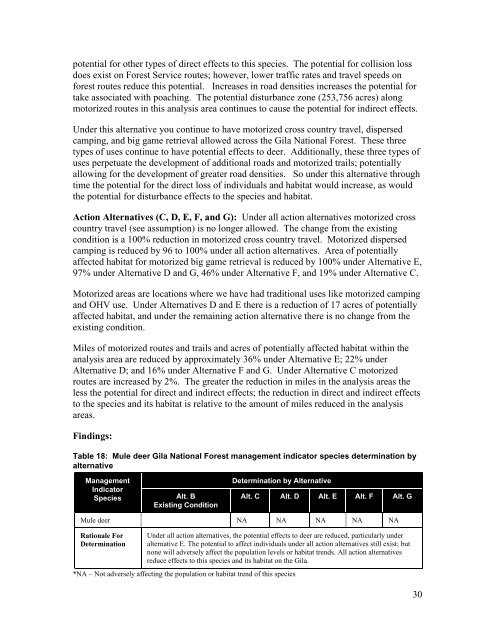Wildlife Specialist report
Wildlife Specialist report
Wildlife Specialist report
You also want an ePaper? Increase the reach of your titles
YUMPU automatically turns print PDFs into web optimized ePapers that Google loves.
potential for other types of direct effects to this species. The potential for collision loss<br />
does exist on Forest Service routes; however, lower traffic rates and travel speeds on<br />
forest routes reduce this potential. Increases in road densities increases the potential for<br />
take associated with poaching. The potential disturbance zone (253,756 acres) along<br />
motorized routes in this analysis area continues to cause the potential for indirect effects.<br />
Under this alternative you continue to have motorized cross country travel, dispersed<br />
camping, and big game retrieval allowed across the Gila National Forest. These three<br />
types of uses continue to have potential effects to deer. Additionally, these three types of<br />
uses perpetuate the development of additional roads and motorized trails; potentially<br />
allowing for the development of greater road densities. So under this alternative through<br />
time the potential for the direct loss of individuals and habitat would increase, as would<br />
the potential for disturbance effects to the species and habitat.<br />
Action Alternatives (C, D, E, F, and G): Under all action alternatives motorized cross<br />
country travel (see assumption) is no longer allowed. The change from the existing<br />
condition is a 100% reduction in motorized cross country travel. Motorized dispersed<br />
camping is reduced by 96 to 100% under all action alternatives. Area of potentially<br />
affected habitat for motorized big game retrieval is reduced by 100% under Alternative E,<br />
97% under Alternative D and G, 46% under Alternative F, and 19% under Alternative C.<br />
Motorized areas are locations where we have had traditional uses like motorized camping<br />
and OHV use. Under Alternatives D and E there is a reduction of 17 acres of potentially<br />
affected habitat, and under the remaining action alternative there is no change from the<br />
existing condition.<br />
Miles of motorized routes and trails and acres of potentially affected habitat within the<br />
analysis area are reduced by approximately 36% under Alternative E; 22% under<br />
Alternative D; and 16% under Alternative F and G. Under Alternative C motorized<br />
routes are increased by 2%. The greater the reduction in miles in the analysis areas the<br />
less the potential for direct and indirect effects; the reduction in direct and indirect effects<br />
to the species and its habitat is relative to the amount of miles reduced in the analysis<br />
areas.<br />
Findings:<br />
Table 18: Mule deer Gila National Forest management indicator species determination by<br />
alternative<br />
Management<br />
Indicator<br />
Species<br />
Alt. B<br />
Existing Condition<br />
Determination by Alternative<br />
Alt. C Alt. D Alt. E Alt. F Alt. G<br />
Mule deer NA NA NA NA NA<br />
Rationale For<br />
Determination<br />
Under all action alternatives, the potential effects to deer are reduced, particularly under<br />
alternative E. The potential to affect individuals under all action alternatives still exist; but<br />
none will adversely affect the population levels or habitat trends. All action alternatives<br />
reduce effects to this species and its habitat on the Gila.<br />
*NA – Not adversely affecting the population or habitat trend of this species<br />
30
















